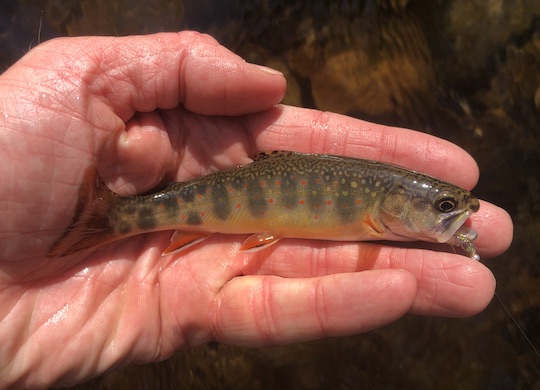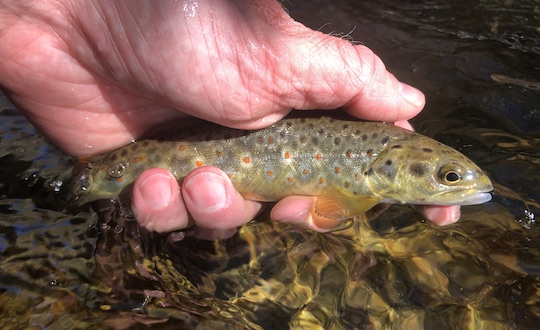For those interested in what is happening with the Caney Fork, here is what I sent to the Corps of Engineers about the changes that need to happen on the Caney Fork. Please consider sending in your own comments to Cody.A.Flatt@usace.army.mil and note that they need to be in no later than June 4.
Hello,
Thank you for allowing the public to get involved in the process of updating the water control manual for Center Hill Dam and considering all pertinent data in the decision making process.
As a fly fishing guide whose livelihood relies on healthy rivers, this is a topic of special significance for me. Prior to the dam repairs which began in 2008, the Caney Fork River below Center Hill Dam enjoyed an excellent minimum flow due to the leakage around and under the dam. Due to the very real risk to the dam, this leakage was appropriately remedied through the 3 phases of the dam repair, but in the process, eliminated the needed minimum flow that had created one of the best trout fisheries in the southeast.
The dewatered riverbed no longer supports anything close to the biomass it did before the dam repairs and the trout population is suffering as a result. What we need is to not only return the Caney Fork River to the level it once was, but add additional improvements in the process.
Natural reproduction in the trout population has long been something that would be nice to see but hasn't happened to any significant level. Water quality is one of the prime suspects in the lack of natural reproduction in the Caney Fork River, particularly low dissolved oxygen levels. As funding is always a problem for hatchery programs, natural reproduction would be a great (although not guaranteed) by-product of better water quality.
To achieve the goal of a vastly improved fishery, I recommend the following items be mandated in the upcoming water control manual.
The Caney Fork River needs continuous minimum flows. This will achieve several things.
First, continuous minimum flow will keep more of the riverbed wetted and quickly boost biomass. The macroinvertebrates that trout depend on for food cannot survive in dry riverbeds. The gravel bars that have made the Caney Fork famous need continuous minimum flow of between 200 and 500 cubic feet per second (cfs). Ideal targets would be in the 300-450 cfs range. This should be accomplished through utilization of the orifice gate during times of no generation. Some of the best fishing in recent memory happened in 2016 when minimum flows were utilized via the orifice gate. That gives us some idea of what the river is capable of when the proper flows are maintained.
Second, more water in the river will reduce user conflict. As a fly fishing guide, I routinely have people say ugly things when I float through "their" water. Unfortunately, with the current flow regime, there is often a 6-10 foot wide corridor that is deep enough to float a boat (canoes, kayaks, drift boats like mine, etc). Years ago, prior to the dam repairs. there was vastly more water with enough depth to float small craft. Spreading users out means that boaters can be polite and avoid ruining wading anglers' water. It is means we don't have to be as hard on our boats. I routinely have to drag my boat through shallow water that used to stay deep enough to hold fish.
Third, more water in the river will give refuge to the fish. The ability to spread out means fish will be better at avoiding predators, both anglers and natural predators. This in turn will help fish to hold over and grow better in the river, increasing angling quality through larger average catches. Prior to the dam repairs, it was common to catch several heavy trout in the 14-18 inch range each outing. Now, the river is primarily full of small recently stocked fish. The water quality and space to grow just isn't sufficient to support large numbers of holdover trout.
Next, after establishing continuous minimum flow, we need to make sure and keep that water well oxygenated. Low dissolved oxygen (DO) is a well documented problem on the Caney Fork River. During periods of low DO from the generators, the sluice gates should be utilized to help boost DO levels. Further, I recommend utilizing liquid oxygen on the dam side of the embayment at depth to help improve oxygen content before the water passes through the generators. This has worked very well on rivers like the Clinch in east Tennessee and has improved that fishery immensely. Specifically, oxygen needs to be maintained in the Center Hill tailwater that is at least a minimum of 6.0 mg/L at all times.
If these two goals are accomplished, other important goals should also be addressed including:
-Keeping temperature change rates to less than 3.5 degrees fahrenheit per hour
-Maintaining water cold enough to support trout at least down to Stonewall Boat Ramp
Currently, I often measure water temperatures approaching 70 degrees on the river before daily water releases hit. Having water temperatures swing by 15-20 degrees in a matter of minutes is hard on the fish and the macroinvertebrates and even the weed beds that provide habitat for both. Water is rarely cold enough to support trout in the summer months as far downstream as Stonewall. Prior to the dam repairs, trout could often be found all the way to the Cumberland River. The current lack of minimum flow has pushed the trout fishery into the upper 7 miles of river below Center HIll Dam, concentrating anglers and leading to more pressure than that much river should deal with. Spreading anglers out further down the river will also aid in reducing user conflict.
Finally, I would recommend limits be placed on the number of generators that can be turned on or off per hour to no more than one unit at a time. Abrupt changes often have the unintended effect of stranding fish where they cannot get back to the main riverbed. Slower changes give all the fish the chance to move back and forth from high water to low water spots.
All of these changes will have a tremendous economic impact on the local area. Currently, as a fly fishing guide, I won't book trips past September 1 on the Caney Fork due to the very poor fishing that happens by late summer through the fall. This means that there is at least half a year of lost economic opportunity for local communities.
Many of my clients travel from out of state, and stay in local hotels, bed and breakfasts, cabins, and eat in local restaurants, etc. They will fish with me for anywhere from 1-4 days in a row. Since I mostly only book trips on the Caney Fork May through July and recommend people don't bother fishing it later in the year, that adds up to a lot of people not spending their money in the local area, instead opting for better options further east. Water quality improvements on the Caney Fork will open up more economic possibilities in the local area. A great byproduct of good water management!
Let's see the Caney Fork River below Center Hill Dam turned into a quality trout stream instead of a river that happens to have some trout in it.
Thank you for your time and consideration of this very important goal.
Sincerely,
David R. Knapp
Trout Zone Anglers






